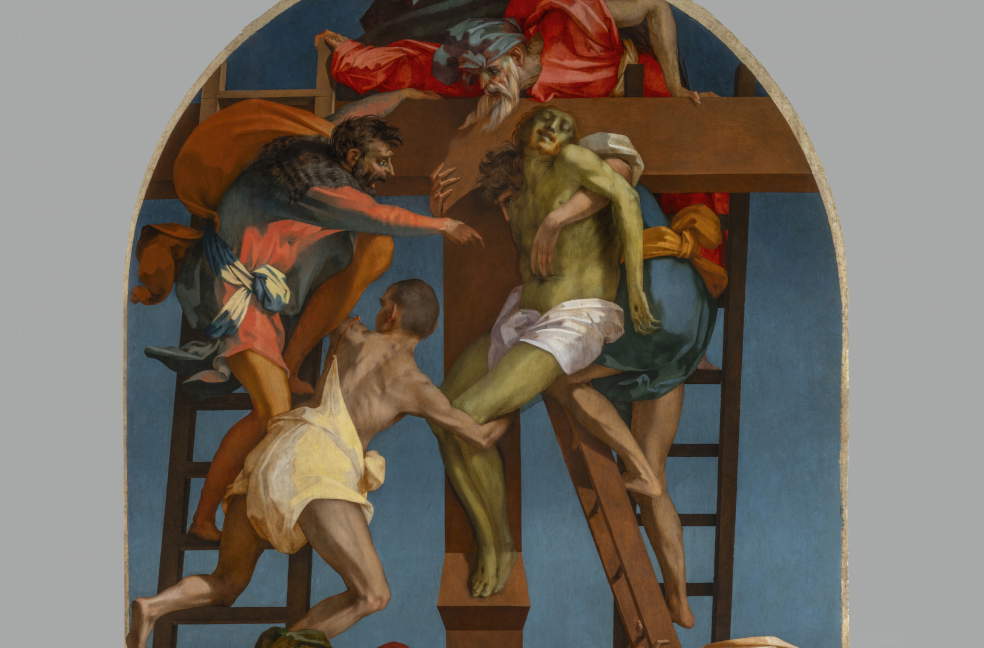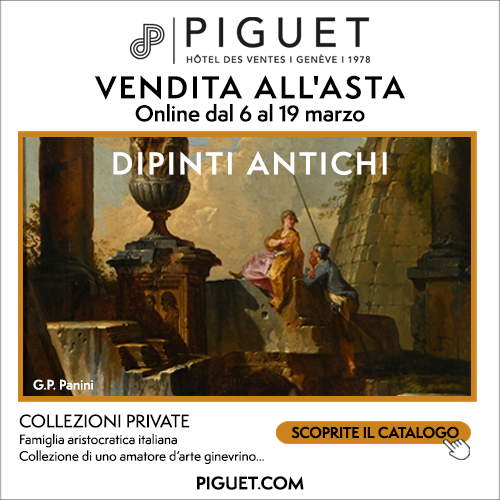Rosso Fiorentino's Deposition is back on display restored at Volterra Art Gallery
After a two-year restoration project fully funded by the Friends of Florence Foundation thanks to donations from John and Kathe Dyson and the Alexander Bodini Foundation and carried out under the guidance of the Technical and Scientific Committee for the Study, Monitoring and Restoration of Rosso Fiorentino ’s Deposition - Pinacoteca e Museo Civico di Volterra, coordinated by the Soprintendenza archeologia belle arti e paesaggio for the provinces of Pisa and Livorno, with the participation of the Municipality of Volterra (Pinacoteca e Museo Civico / Ufficio Cultura, Turismo ed Eventi), the Diocesi Vescovile di Volterra (Ufficio Beni Culturali Ecclesiastici), the Friends of Florence Foundation and Andrea Muzzi, Rosso Fiorentino ’s Deposition from the Cross is back on display at the Pinacoteca Civica di Volterra. In fact, having completed its restoration, the painting has been relocated to Room 11 of the Volterra Civic Art Gallery, which was specially set up thanks in part to a partnership between the Municipality of Volterra and Iren luce, gas and services.
Following the display of the painting at the exhibition The Sixteenth Century in Florence held in 2017 at Palazzo Strozzi, a reflection arose between art historian Andrea Muzzi, then Superintendent of Pisa and Livorno, restorer Daniele Rossi, the Diocese and Municipality of Volterra and Friends of Florence on the state of conservation of the masterpiece. This reflection led shortly thereafter to the very restorer who had already worked on Pontormo’s Deposition, also on display at the Florentine exhibition and whose intervention was supported by Friends of Florence, to present the restoration project to the American foundation with the high supervision of the Superintendency and the agreement of the owners’ bodies. The intervention, started during the pandemic in September 2021, was carried out, directly in the Pinacoteca Civica in Volterra by restorers Daniele Rossi for the pictorial part and Roberto Buda for the wooden support. The open construction site allowed the museum not to take the work completely away from visitors and to show its complex restoration work.
The delicate restoration work on Rosso Fiorentino’s Deposition was necessary to address two critical aspects that the panel presented: the distressed situation of the wooden structure, due primarily to the now blocked crossbeams, which reverberated on the paint film in the form of color deadesions and the now altered pictorial retouching attributable to previous restorations. The occasion was also a very valuable opportunity for in-depth study of the work: in fact, today, after the restoration is complete, there is greater knowledge about Rosso Fiorentino’s way of working, the painting’s meanings, and how the artist chose to represent the Deposition of Christ from the Cross, achieving a unique synthesis of spirituality, pain and compassion.
Diagnostic investigations made it possible to identify the preparation of the pictorial layers, the binders and the original colors of Rosso Fiorentino’s palette, which was found to be rich in precious pigments, such as lacquers (garanza lacquer and verdigris), orpiment, Pb-Sn yellow, cinnabar and azurite/malachite. It was also possible to ascertain the use of rock alum, from the Volterra quarries, and vitreous powder (a material often used in the sphere of 16th-century Venetian painters to give greater luster and transparency to the pictorial layers).
Reflectographs also provided extraordinary insights into the patterning underlying the pictorial film. Corrections, or regrets, that the artist made during the course of the work were discovered, documenting, for example, the way Rosso had first outlined the figures of the Marys. The change in the final drafting of the work testifies to Rosso’s sensitivity to the spiritual issues also raised by theologians, translated in the case of the Marys, into a participatory depiction of the Madonna’s state of mind, subtly suspended between suffering and difficult control of emotions.
Although some inscriptions, traced with ink normally used in drawings on paper, were already known, such as those under the color of the ribbon on the head of Magdalene or on the garment of the pious woman, inserted as a reminder for the painter himself on the laying of the final color, others emerged during the cleaning, such as the inscription (biffo) on the garment of the boy holding the ladder and referring to the purple color described by Cennino Cennini in his treatise, or the inscription (biffo ciara) on the loincloth of Christ. The artist in some cases maintains the color indicated by the inscriptions, in others totally changes the color marked in the preparation stage.
The cleaning of the pictorial surface was accomplished with the use of differentiated solvents and supportants, to allow a gradual lightening of the restoration varnishes previously spread on the polychromes. In particular, on the red and green organic lacquers, but also on the yellow-orange orpiment-based coats, the intervention was calibrated, so that some residues of older, though not original, varnishes were preserved, while the retouches at the gaps and cracks were removed punctually. On the sky, the removal of the altered varnishes allowed the recovery of the sky-blue color, based on azurite and white lead, which is still fully appreciable, highlighting, however, the presence of diffuse splash-like stains, probably attributable to old fixatives altered and incorporated into the pictorial layer in such a way that their retention was preferable so as not to risk affecting the original color. The removal of the restoration fillers present at the gaps and woodworm holes was carried out mainly by mechanical means and partly with solvent gel on the cracks: it was also considered appropriate that some of the fillers be retained so as to avoid weakening the color surrounding the gap. Acrylic resin-based fixings were made in the vicinity of the cracks, which had been filled in the past with glue and wood sawdust, materials that were totally removed where possible during the plank alignment operation. Much of the surface and the woodworm holes were cleaned, then grouted again before the final plaster and glue grout, and, after a shaving by scalpel, the structural imitation of the relief brushstrokes was carried out with brush passes of plaster and glue. Limited to the larger gaps, burnishing with agate stone followed.
Particular attention was paid to the phase of pictorial reintegration, carried out by hatching on the interpretable lacunae, which had already been filled previously in coarse strokes and following the same technique, while on some abrasions tone lowering was used. Smaller lacunae and woodworm holes were retouched with tempera. At the end of the restoration intervention the painting was varnished with a brush and by spraying.
The restoration work on the wooden support was carried out to reduce the suffering of the panel and the painted surface. Therefore, the aluminum crossbeams, their anchoring bridges, wooden butterflies and wedges used in the 20th-century intervention were removed and replaced, after careful cleaning of the seats, with aged poplar wood dowels. The planking was freed from the metal crosspieces and replaced with chestnut wood crosspieces placed at the locations of the original crosspieces. Once the rehabilitation was completed, anoxic disinfestation in a nitrogen-modified atmosphere and subsequent treatment with woodworm biocide was carried out.
“Today concludes one of the most important operations that were part of the Volterra Prima Città Toscana della Cultura 2022 project: the restoration of Rosso Fiorentino’s Deposition from the Cross. A long intervention carried out in the place where the altarpiece is normally kept during which visitors had the opportunity to witness the various stages of restoration,” said Volterra City Mayor Giacomo Santi. “It is one of the most important operations as it is an investment for the city, made in one of Volterra’s most important cultural institutions, destined to be admired for a long time. Thanks to the generosity of donors and the mediation of the Friends of Florence Foundation, it has been possible to initiate the restoration of one of the most important works among those preserved in our museums. A work that constitutes the heart of the Pinacoteca and that can now continue to be admired by citizens and visitors in its new location with the renovated layout.”
"The restoration of the Deposition of Volterra is, once again, testimony to the very high technical and scientific level of our restoration culture, witnessed here by the magisterium of Daniele Rossi and Roberto Buda, whose operativeness was accompanied at all stages by the expertise and passionate participation of the staff of this Superintendency," said Valerio Tesi, Superintendent, Soprintendenza Archeologia Belle Arti e Paesaggio for the Provinces of Livorno and Pisa. “And once again the preservation of our exceptional cultural heritage finds the generous, participatory attention of Friends of Florence and its president, Simonetta Brandolini d’Adda, to whom the dearest thanks of all of us go.”
"We have come to the end of a long and very important project indeed: having proposed and then supported the restoration of Rosso Fiorentino’s Deposition from the Cross, a cornerstone of world art history, has been a real honor for us. In addition to preserving the work by intervening on the critical aspects that the panel presented, the intervention allowed us to deepen our knowledge of the execution technique and the artist’s choices during the work. I thank the Municipality, the Diocese, the entire Technical Scientific Committee for the study, monitoring and restoration of Rosso Fiorentino’s Deposition, the restorers Daniele Rossi with his work team and Roberto Buda who with great dedication and experience carried out the intervention. As President I express on behalf of all Friends of Florence my deepest gratitude to donors John & Kathe Dyson and The Alexander Bodini Foundation whose support made this fascinating intervention possible," concluded Simonetta Brandolini d’Adda, President of the Friends of Florence Foundation.

 |
| Rosso Fiorentino's Deposition is back on display restored at Volterra Art Gallery |
Warning: the translation into English of the original Italian article was created using automatic tools. We undertake to review all articles, but we do not guarantee the total absence of inaccuracies in the translation due to the program. You can find the original by clicking on the ITA button. If you find any mistake,please contact us.






























